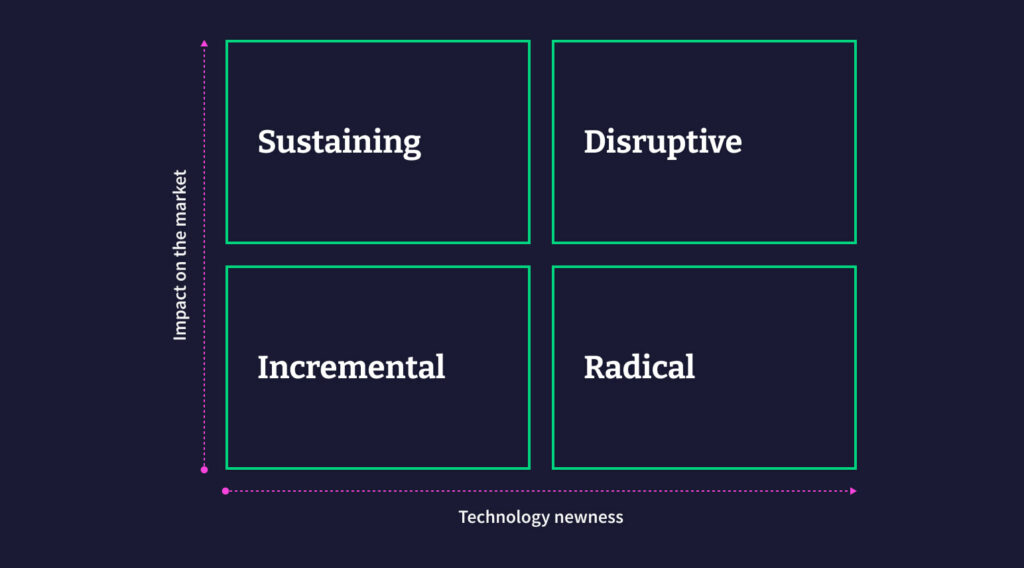

The pathways to innovation
Inevitably, to navigate from A to B, you’ll need to adapt speed and direction.
Innovation theory is in plentiful supply, but it’s the rare ability to switch tracks that needs our attention. At Else, we ensure client projects are fit to handle gear changes. Here’s how to navigate a multi-terrain future.
Satnav for innovators
This well-worn matrix maps change pathways against two factors – market impact and newness of technology. It’s low-fi, quick for context and funnels innovation by type: sustaining, incremental, disruptive or radical. A useful lens as transformation starts, at Else, the matrix comes into view after a Future Backwards session, a diagnostic tool that unites client teams around evolution.

The classic framework, or grid, reveals the kind of innovation that matches business maturity or commercial condition.
- Sustaining – you want to significantly improve an existing product or service to maintain a market position over time.
- Incremental – the gradual improvements you plan to make to established products or services, with dual focus on the short and long term.
- Disruptive – you have a new technology or business model with the power to displace a market.
- Radical – this technological breakthrough will transform your industry and beyond to create a new market. It’s a rarely seen, much talked about bird.
What does first-hand experience tell us?

Photo by: Sebastian Svenson
Business innovation needs can morph overnight. Gentle change becomes an aggressive sprint in light of a new budget, technology or regulation; many internal and external factors weigh in – including perception.
What feels like a radical innovation project from inside the organisation can represent an incremental change in the market. Managing the layers of each project, and negotiating these nuances, requires operational and mental agility for internal and consultant teams like ours.
Primed for change
These insights from the frontline can help internal innovators – or change agents, as they’re defined at Else – and their stakeholders envisage what a real change programme feels like.
Be open and rediscover the brief
Tasked with sustaining innovation that would digitise Shell’s on-forecourt loyalty programme, it took wider investigation to diagnose a more expansive shift. For instance, a pay-at-pump app would compete with the app in the brief, and both would divert footfall from Shell’s retail offer inside the petrol station.
The project grew wings with 50 ideas to tempt all drivers to choose Shell over other petrol stations, beyond the traditional bounds of loyalty cards – including a fuel valet for those preparing for long journeys. This ‘Loyalty as a service’ concept now did two jobs: it mapped a more disruptive route to change and opened the door to incremental innovation – a better long-term loyalty scheme.
Use design to manage risk
For Switzerland-based Loterie Romande or LoRo, an e-gaming platform we designed underpinned a sustaining change programme. The platform represented a leap in evolution for LoRo and felt like a disruptive move.
With all metrics smashed and player volume doubled, organisational confidence rose in line with new capability – LoRo’s CEO was then President of the World Lottery Association, and changes were subject to scrutiny. The platform unlocked opportunities to build engagement around basket value and personalisation incrementally, taking the organisation boldly into the future yet in a natural way.
Constant calibration is key

Photo by:Ryoji Iwata
The ‘ready for change’ exercise we do before designing any innovation route is vital for two reasons: it mitigates risk and aids measurement of results. But it can be used at any point in a project to diagnose the right pivot. Here’s the shorthand:
- Create awareness – does the business know there’s a need to switch approach?
- Foster consensus – do we agree on how that walks and talks?
- Test appetite – how hungry are we for this type of change?
- Assess capability – where are the gaps against a new customer journey?
When pressure is high, these four factors rule a new pathway in or out at speed. For example, incremental innovation copes with a lack of consensus about the type of shift that needs to be made in a product or service, where a radical or disruptive route will carry higher risk and is more likely to derail a project early on.
Be practical with the models
Theoretical innovation models are limited by being wide enough to fit an audience, but they stay valuable when adapted case by case.
As you contemplate the road ahead, don’t get too attached to a style of innovation or allow the classic matrix to conflate intention with outcome. A sustaining innovation track won’t leave a company in the same place, with an unchanged historical advantage – it might transform a business. Because these three things could be true at once:
- We’ll take an incremental approach to change – we’re naturally cautious.
- It’s going to feel disruptive for us.
- Given the power of experience design, we can radically impact the market.
Write your own terms
Real innovation journeys are varied and complex, requiring a custom blend of approaches. Crucially, the pathways used are not the strategy for success; they’re a toolkit. Good outcomes stem from smart diagnosis and deft steering of the change and the teams involved.
Readying for transformation?
Get prepared with our four-part series on making change happen, or contact the Else team for advice on innovation journeys.
The change series
Helping you think how to successfully challenge the status quo and move through uncertainty, towards clarity.
Else briefing
Don’t miss strategic thinking for change agents
One more step
Thanks for signing up to Else insight
We’ll only email you when we release an update.
Please check your email for a confirmation link to complete the sign up.
You’re all set
Ah! You’re already a friend of Else
You won’t miss any of our updates.
In the meantime, please enjoy Our Insights
Shared perspectives
Don’t miss strategic thinking for change agents
Find ideas at your fingertips with Else insight.
Here to help
